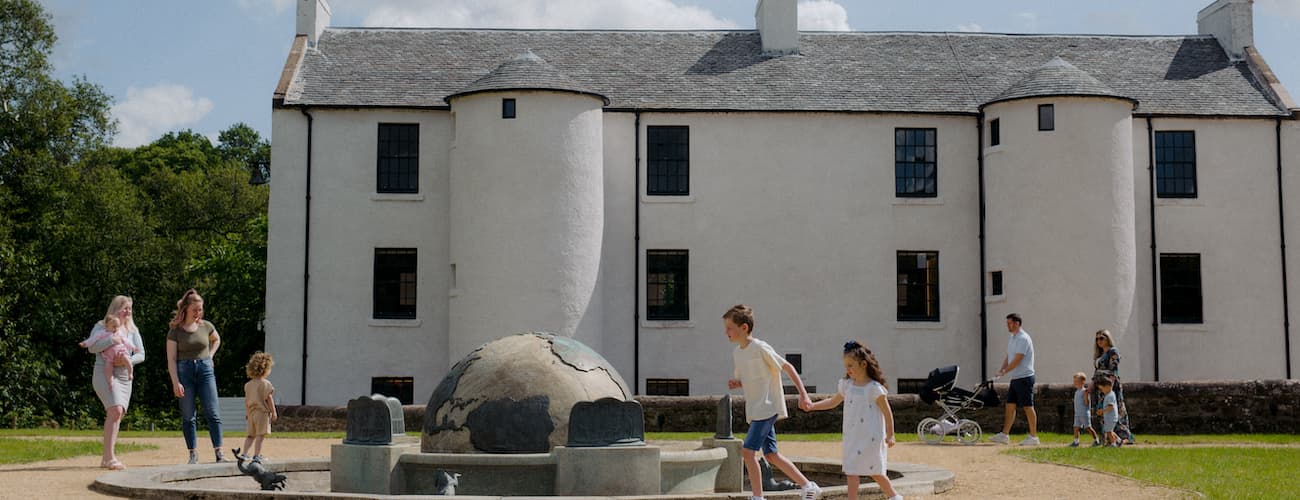Our Stories. Episode 1 - How We Remember and Reflect on the Past
Transcript
Narator: Before this podcast begins, we wanted to give you a gentle warning - this podcast can be a hard listen at times and includes themes and discussions of trauma, racism, colonisation and more. It’s something you might need to consider before listening.
EA: Whilst storytelling can help us understand others and ourselves, we often have to navigate myths and memories that hold conflicts or truths overtaken by others. BUT…for many understanding their past, their families, their roots - it can be the one thing that brings real connection to ourselves and those around us.
In late 2022, Scottish-Zimbabwean artist and researcher Natasha Thembiso Ruwona programmed an event titled Our Stories Between the Myths and Memories in partnership with The Skinny. Hosted at David Livingstone Birthplace in Blantyre, Natasha brought together a wealth of creative practitioners from the Scottish African diaspora to celebrate their contributions to the creative sector.
Natasha’s aim was to let the project speak to past, present and potential futures that examine Black Scottish history, culture and identity. And why the location? Well, it placed a spotlight on the work that David Livingstone Birthplace are doing as they consider the role of museums within truthful storytelling.
My name is Eilidh Akilade, I am the intersections editor at The Skinny and over this 4-part podcast series brought to you by the magazine in partnership with We Are Here Scotland, you will experience some of the conversations, questions, creativity and reflections that came out of that weekend.
Welcome to Our Stories…
In this first episode, we explore how we remember and reflect on the past. What has this commission evoked for people? How have they navigated their past experiences and stories? And what questions do they have now?
Part 1: Natasha Ruwona + Mbira)
EA: We start with a piece by Natasha who composed a response to David Livingstone Birthplace
Between waterways and memories grounded in dreams what could be or have been. a play on geography storytellers, mythmakers from the cloud to the motherland streams in confluence time travellers meet. Home is found in a renaming memory-making game Blantyre, Malawi, Livingston. Zambia a renaming memory mistaken placemaking Victoria Falls, claims of discovery located in a stone embodied river system in search of the source in search of Zambezi Nile Zambezi, home is found in water that rumbles, truth is found in water that speaks. Whispers of waters holding magical resources liquid dreams grounded in streams, potential trade routes and expansion of empires of silence and spells revered and remembers the mythologising of nationalism glory heroism. A commitment to knowing remembering memory making [inaudible] remembering placemaking mythical black geographers who knew that the land was held within the body and the body within the land. Time travellers forgotten carriers between facts and fiction memory lies rest awakens between facts and fiction might be moralisation the body as is the passage. And their commitment to memory museums storytellers mythmakers transport geographies and times holders finder keepers conversations with ghosts turned objects that silent objects turned memory. Memories turned lower truth-tellers mythmakers sites of omitted citations contested history as the museum haunts time is mirrored and breathwork time filled in shapes time held in weight as the museum haunts dreaming maybe of a possible feeling the slowed breathing the transferring of energy feelings restrictions the transferring of memory or dreaming maybe.
Part 2: Adebusola Ramsay and Tomiwa Folorunso
EA: You will hear parts of a conversation throughout this series between Adebusola Ramsay and Tomiwa Folorunso which takes a look at Adebusola’s decolonisation work and navigating difficult histories.
Adebusola is a visual artist, whose practice has developed over the last two decades. Her work features evocative colour composition and textural detail, mostly with acrylic medium, and explores different forms of mark-making. It’s influenced by patterns and symbols, in particular weave and pattern-making of African cloths such as Aso-Oke, Kente and Adire. And Tomiwa is a writer, presenter and creative. Her work explores the experiences of marginalised voices and seeks to connect people, ideas and stories.
What's a safe space for one person or group is oftentimes not a safe space for everyone. You are about to hear Adebusola talking honestly about why she finds museums difficult places to be in…
Tomiwa: I'm thinking about how we're in a museum or part of a museum. And also about what you were saying about walking the streets of Glasgow and how that critical thought, but also the joining of the dots and asking the questions and realising that, yes, we are living in white supremacy and the remnants of colonisation. And then also thinking about institutions in general, like art institutions, cultural institutions. And, you having done all this research and knowing this thought and how it intersects with your art, and also, I suppose, how does it feel then, like, going into those spaces, knowing everything that you know?
Adebusola: Well, let me back up a little bit and just say it's not just the art. Even in my day job, it finds its way. And I work in public health, and a few years I'm a member of a group called the Scottish Migrant Ethnic Health Research Strategy Group. And a few years ago, we tried really, really hard to put on a seminar series with Glasgow Centre for Population Health. And I remember one of our chairs, um, having long, long discussions, trying to negotiate the title of the seminar. I was asked to open the seminar to basically set the historical context because they inadvertently booked a building, a church in Glasgow, um, St. Andrews Church in the Merchant City area. But they didn't know the history of the church. And it was essentially built by slave owners and plantation owners and slave traders and people who relied on slave-produced goods for their industry. They built this private church for themselves. It's massive, huge. Like, it's ornate. It's all, it's got a gold ceiling. And they booked this building, but they didn't know the history of it. So I was asked to just basically set the context. And the title that we settled on was considering, so this is in 2018, Considering Racism as a Fundamental Cause of Health Inequality, that was controversial in 2018 to say in public health. Obviously, with the pandemic happening and the disproportionate mobility and mortality that happened to black people and black and Bangladeshi people and Pakistani people, it became more acceptable and more accepted. The British Medical Journal has had a takeover where they were essentially declaring that racism is a public health issue, it's a public health emergency. And I remember posting at the time just basically saying, it has been a public health emergency ever since. You created race ever since, you've been doing racism ever since. So that's been 600 years that it's been, um, ever since the beginning of Chattel with slavery in the 1400s, racism has been a public health emergency because it's destroyed and terrorised, you know, if you see, if you understand what Chattel slavery was, it was terrorism on a scale unimaginable today. And so it has been a public health emergency for 600 years. And for us to only be able to talk about that because the Black Lives Matter protests are happening because a Black man was killed indiscriminately in the street for everyone to see. And the only reason you're paying attention is because we're all home. There's a pandemic going on. You can't go anywhere, you can't do anything because how many Black men have been killed in the street? And you've seen the videos, it didn't really matter then. But now is the time that you're paying attention in June 2020. And that's what it took was a pandemic to happen at the same time. And so it affects all aspects of the work that I do, whether it's my day job or the art. And there are certain spaces I don't go into. I don't do museums. I don't go into museums because I find them violent places and spaces because of the way… it's hard for me to watch my culture or the culture of people from my continent treated as curiosities inside a cabinet. That's difficult for me. It's hard for me to watch the language and to read the language that's used to explain why you've got certain things or how you acquire them, or the obfuscation that people go through from actually saying what it is I'm looking at here. You know, that's difficult for me. And so why am I going? I mean, I don't have that much free time, right? We all lead busy lives. We all need to work and like, what most of us need to work and all the rest of it. I'm not going to go and spend my private time, my leisure time, being in spaces that are extremely uncomfortable for me to be in. But every now and again, I do have to go into these spaces. And when I do, it's a lot of work. Because the processes of thinking critically about what you're being presented with has to be working and you have to be doing it, and you need to be doing it fast and you need to be thinking very quickly and you need to be reading between the lines. You need to be, Christina Sharp talks about this process of thinking otherwise. Black, redaction, Black annotation it's like taking out the superfluous information and taking out the violence in people's language and how things are constructed and how things are visualised and how things are presented and having the critical thinking processes to be able to add in the things that aren't being talked about. Llike, did someone just why are you travelling to Africa? Why are you going there? Why have you got cotton mills? Where did the cotton come from? You've missed that bit out. You've missed the bet about the enslaved people. You've missed that bit out. So I need to then put it in as I'm reading your museum thing or whatever. And that's a lot of work, that's exhausting. And so I would rather not do that unless it's deliberate work where I know what I'm walking into I know what I'm there to do. I'm doing it as a job and I'm going to be doing something with that information. I'm going to be confronting the institution, the archive, the historians, I need to be doing something with it, because it's not going to sit on me. Mhm, you know, why should it sit on me, you know, so unless I'm going to be doing that with the information, then there is no point in me being in those spaces. And it really irritates me that everyone's talking about decolonial this and decolonial that. If it's decolonial, you'd shut it down and send all the stuff back. That's what it actually means to be decolonial. And I'm not going to pat you on the back for giving back the Benin bronzes because you should have never had it in the first place. You come in at my house and burgle it. You don't get cookies for handing the stolen stuff back. That's not how our legal system works. So why should it work for colonial processes? You don't get claps for ending slavery. You don't get claps for letting countries have their independence. That's not a good, that's not, you doing a good thing.
Tomiwa: Yes, you still did the bad thing.
Adebusola: And those things only happened by violent resistance. It didn't happen because you were a good guy. I mean, how long have people been campaigning for museums to send these artefacts or these curiosities? They don't even know what they are. They don't understand the cultural, the spiritual context for those things being created. And so they're just sitting in a cabinet in your museum or in your archive collecting cobwebs and nobody ever sees them. And so you don't get to be applauded for returning stolen goods or goods that were acquired via nefarious means. You don't get that. Ah, I'm not going to congratulate you for that. So yeah, I find museums really difficult.
I wanted to explain a bit about chattel slavery to put this a bit more in context so that we can look at that within this episode of remembering and reflecting on the past. The word “chattel” is defined as a personal possession - so comes the term chattel slavery and classing enslaved people as chattels. As part of this extreme violence, enslaved people were bought and sold at will. Whilst for many it’s important not to solely explore the trauma experienced by the African diaspora, it’s still necessary to understand why Adebusola and so many others have such difficulties within certain spaces.
What white counterparts may experience within a museum and cultural context is something completely different for Black People and People of Colour or those who have experienced historic violation. AND this is where we can start to open up the conversation and hopefully make larger audiences understand the impacts of these things on the here and now, as well as how we within the African diaspora navigate our own stories.
It’s easy for people to take a walk into a museum, stand and muse over an artefact for a few minutes, read the placard and create a narrative around it - but there is no lived experience in this. A possession that belonged to someone else that perhaps brought them spiritual enlightenment, or connected them with another person or was an expression of their art and humanity now has violence attached. But those people wandering around these cabinets and displays, they will never fully understand the impact of that or even the full history behind it. What benefit does it really bring to a museum to house these?
This also ties in with Adebusola discussing St. Andrew’s church and the disconnect of people not knowing the full history behind somewhere but inadvertently placing those who feel least comfortable within that cultural space. When does the education and awareness really begin?
So how do we reflect on that? Well, Natasha’s approach to their curation within David Livingstone Birthplace was, in their words, about thinking how to bring communities into the space and what brings people together. Through reflecting on the stories that David Livingstone Birthplace are housing and the stories told by African-Scottish diaspora artists we can look at how these bridge people. And so, storytelling became the overall theme.
And I guess if we bring storytelling back into the picture and our reflection on the past, let’s ask a question - can creatives from the African diaspora change the narrative of how museums move going forward? Could this be through a new type of curation? David Livingstone Birthplace started to address some of these conversations as Natasha spent a year as a researcher for them.
Natasha spoke about not going into the place with the intention of changing it as they didn’t believe this was healthy. The approach was, amongst other things, about provoking alternative ways of thinking. It was about raising new questions, challenging narratives and bringing new storytellers into a historic environment.
Could this be an example to others?
Part 3: Tomiwa Home Part 1
EA: We go back to meeting Tomiwa Folorunso who was an integral creative and storyteller over the weekend. And this is where artistic expression built a bridge between reflection, remembrance and this historic space.
The following piece Ghar Ile Home written by Tomiwa and Hanza Hussein who is originally from Pakistan is taken from a book called Imagined Spaces by a publishing house at Dundee University called the Voyage Out Press.
My parents married sometime around the middle of 1993. By the end of 1994, they were both here in Edinburgh, Scotland. My dad arrived first. He had a scholarship to study for his PhD in English Literature. Four months pregnant with me, my mum followed him.
The first home I ever had was in my mother's body. I was born on my maternal parent's wedding anniversary, Wednesday 3 May 1995 at, uh, about 6.30am in the morning in Simpsons Children's Hospital in Edinburgh. From 5000 mile away, my grandmother named me [inaudible] Tomiwa, meaning a girl has come looking for me. The first girl of my generation. The first 1st generation immigrant. The first Scottish Nigerian of my family.
Mom said I always thought we'd go back to Nigeria, but dad never taught me you Yuroba, so maybe he hoped we wouldn't. My mum's thoughts became an unlikely wish and my dad's hopes became reality because his PhD took a while. We settled. They made friends, got jobs and I went to a nursery where I didn't want to play with other children because I knew the colour of our skins were different. If home is a physical space, something that can be touched, slept in and lived in, then I am the first, the first of both sides of my family to be born into a home that is not in the same country as that of my parents, but is Britain home? Does indefinite leave to remain mean home to live in a limbo of uncertainty of your future, to know you're at the mercy of a racialised bureaucratic state. Hoping and praying that you have enough time to reap the seeds of the opportunity you've been granted.
Praying - my mom used to take me to the mosque with her. What did she pray for when we went? What did she pray for when she knelt on that mat and bowed her head? Hope, happiness, love. Home. When she raised her head and eyes refused to meet her own. But I saw it. The disgust and the distrust. I felt it. Could she? What does it mean to make a home in a place where even in a last home, where we worship the same God, say the same prayers, blackness still defines you as other?
A fitting way to finish our first episode.
Natasha’s other aim with this event was having space to breathe and connect outside of more challenging conversations. The connection in this excerpt also highlights one of many experiences when it comes to migration, movement and remembering where we came from but also those lingering questions we have internally and from those around us.
On the next episode of Our Stories, we look at joining the disparate dots….
In the meantime, if you want to learn more about David Livingstone Birthplace and make up your own mind, they are located in Blantyre and we will provide more information in the show notes to accompany this episode.
Credits: This podcast from The Skinny was presented by me, Eilidh Akilade, produced, recorded and edited by Halina Rifai and is in partnership with We Are Here Scotland. The live recordings were made by Hamish Campbell of Sound Sound. This series was commissioned by David Livingstone Birthplace and was made possible through funding from Museums Galleries Scotland.






